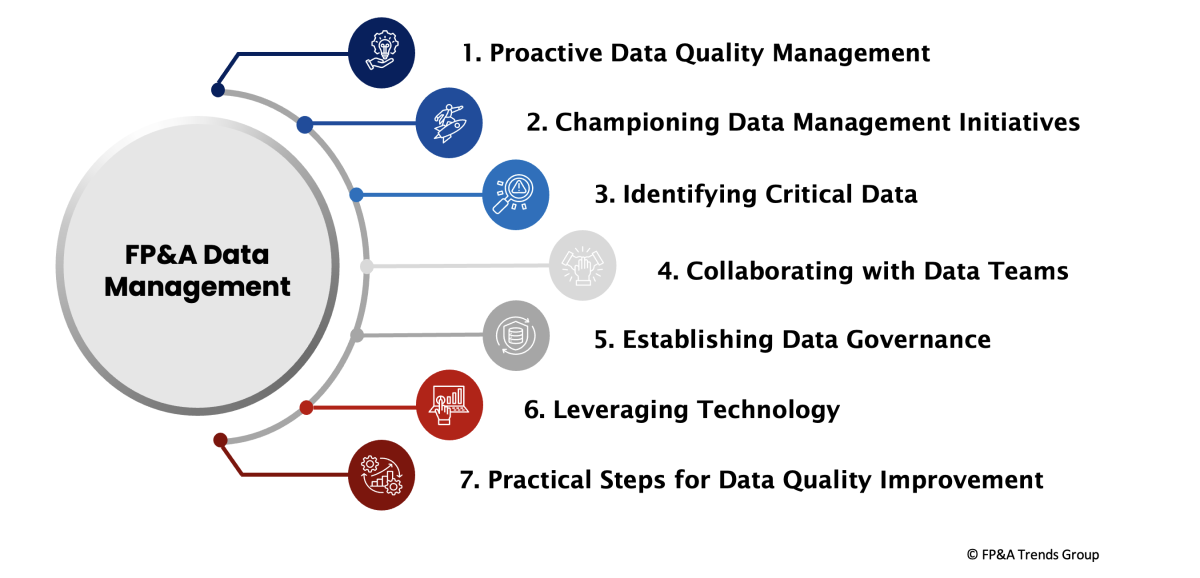A strong data strategy is crucial for FP&A teams to ensure accurate, timely and meaningful insights...

Financial Planning & Analysis is pivotal in today's dynamic business environment, facilitating data-driven decision-making. However, the 2025 FP&A Trends Survey highlights a critical challenge: FP&A professionals spend 46% their time on low-value data-related activities, hampering strategic analysis opportunities.
This article explores how FP&A's data strategies can bolster decision-making and business success, particularly through identifying, validating, and monitoring key drivers and assumptions.
Challenges and Solutions
FP&A departments face diverse challenges: gaining executive support, handling complex data integrations, and managing growing data volumes. The 2025 FP&A Trends Survey reveals that 25% of organisations still operate with low or poor-quality data, severely limiting effective forecasting and analytics. Additionally, 16% report complex and inconsistent data, while 11% cite the absence of a single trusted data source as the biggest blocker in their planning and forecasting process.
To overcome these challenges, strategic solutions are imperative. Centralising data management systems, such as data lakes or warehouses, can be transformative, providing a unified platform for integrating various datasets and enhancing data accessibility and consistency.
FP&A's Evolving Role
Today, FP&A goes beyond just handling data; it actively shapes data strategies. This vital role includes identifying crucial data needs, validating sources, and ensuring data quality.
FP&A professionals are instrumental in scenario analysis, furnishing accurate data for informed decision-making. They continuously refine models, enabling organisations to swiftly adapt to market shifts.
Streamlining Agile Decision-Making
FP&A takes the lead in driving agile and data-informed decisions. Leveraging identified key business drivers and assumptions, FP&A shapes instantly adaptable models critical for scenario planning. By collaborating with data scientists and IT teams, FP&A professionals ensure data strategies remain refreshed to align dynamically with real-time data. This proactive leadership is essential for maintaining a competitive edge.
The Seven Pillars of FP&A Data Management Strategy
The FP&A approach to data management is founded on seven key pillars (see Figure 1), each vital for crafting a robust and effective data strategy:
Proactive Data Quality Management: FP&A actively manages and maintains data quality, sets high standards, and fosters cross-departmental collaboration. For instance, in a leading retail chain, the FP&A team conducts routine audits of inventory data, ensuring accurate forecasting and optimising inventory levels.
Championing Data Management Initiatives: FP&A leaders spearhead robust data management practices, advocating for standardised processes to ensure reliable information for budgeting and forecasting purposes.
Identifying Critical Data: FP&A professionals prioritise data that influences planning and analysis, focusing on strategic decision-driving data and, for example, analysing sales data to identify trends and patterns impacting revenue projections.
Collaborating with Data Teams: Effective collaboration enhances data management, as FP&A works closely with data scientists to develop predictive models and forecast financial performance.
Implementing Data Governance: FP&A establishes clear policies and procedures, such as data entry and validation protocols, to ensure data consistency, accuracy, and reliability.
Leveraging Technology: FP&A uses advanced tools and technologies to enhance data integration and analytics, such as AI-powered forecasting models for financial outcomes.
Practical Steps for Data Quality Improvement: Structured approaches, including regular data reviews and ongoing training, foster data quality improvement and enhance decision-making.

Figure 1. Seven Pillars of FP&A Data Management Strategy
Empowering FP&A with Data Management: Five Key Actions for Success
FP&A professionals must:
Clarify Data Ownership and Role: Redefine FP&A's role to prioritise analysis and interpretation over data management tasks. For instance, FP&A should take ownership of data analysis to ensure its accuracy and relevance.
Define Data Requirements Clearly: Clearly outline data needs in terms of type, format, frequency, and quality. For example, FP&A may require structured sales data to be updated daily with a specified accuracy threshold.
Integrate Driver-Based Modelling and Data Lineage: Fuse FP&A's driver-based modelling with data lineage documentation to demonstrate how operational factors drive outcomes. For instance, tracing sales data lineage helps FP&A understand the impact of marketing changes on revenue forecasts.
Communicate with Data Owners Clearly: Establish transparent communication channels with data owners to align requirements with organisational objectives. For example, FP&A can collaborate with sales to ensure customer acquisition data meets financial forecasting needs.
Collaborate with IT and Data Management Teams: Work closely with IT and data management teams to efficiently refine and meet data requirements. For instance, FP&A can lead in setting data requirements, automating data collection, and implementing quality checks, enabling Finance to play a more proactive role in data management and analysis.
The above five actions enable FP&A professionals to work with the 'right' data, which promotes agile forecasting and insightful decision-making.
Case Study: Transforming Data Management with FP&A at Sella Group
Facing escalating analysis demands, Sella Group, a prominent financial services firm, embarked on a transformative journey to enhance its data-driven decision-making capabilities. Recognising the critical need for streamlined processes and insightful analytics, Sella Group implemented the Board Intelligent Planning Platform.
Under the leadership of Alessandro Basile, Head of Group Planning, Execution, and Control, Sella Group embraced a new organisational model. Basile summarised the model as 'Board as a platform,' integrating reporting, analytics, dashboarding, planning, and business modelling processes across the Group's 20 companies into a single platform.
This adoption enabled the seamless integration of performance management and Business Intelligence functions, empowering teams to leverage real-time data for informed decision-making. The results were remarkable: significant improvements in operational efficiency and customer service metrics were witnessed across the organisation.
This success underscores the indispensable role of FP&A in driving business excellence through effective data management, cementing its position as a strategic asset in the organisation's quest for success in a data-driven landscape.
Future Trends in FP&A Data Management
The FP&A landscape is set for a significant shift due to the rise in AI/ML technologies. These innovations can become integral to FP&A processes as we enter an era of Predictive and Prescriptive Analytics. The 2025 FP&A Trends Survey reveals a concerning trend: only 10% of organisations base every decision on data, a slight decline from previous years. This trend underlines the urgency to embrace these new technologies, gain deeper insights, and enhance strategic decision-making.
In FP&A, data is the rhythm, and technology is the stage. Integrating these elements is not just operational but a strategic imperative for performance in the business world.
Conclusions
Integrating FP&A and data management is a strategic requirement in modern business. High-quality data forms the backbone of an effective FP&A department, enabling enhanced decision-making and strategic planning. The FP&A teams become crucial to organisational success and resilience by embracing these trends and best practices.
This article was first published on blog.board.com
Subscribe to
FP&A Trends Digest

We will regularly update you on the latest trends and developments in FP&A. Take the opportunity to have articles written by finance thought leaders delivered directly to your inbox; watch compelling webinars; connect with like-minded professionals; and become a part of our global community.






